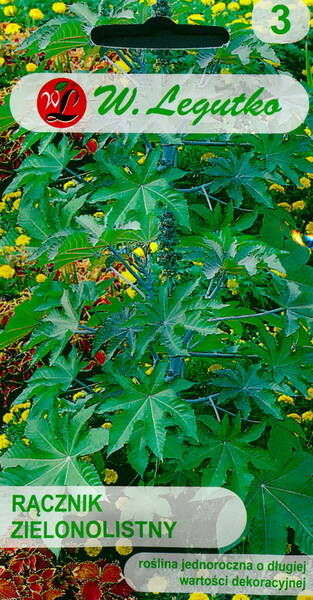The leader of single plantings in your garden!
A perennial plant grown as an ornamental deciduous, annual. The bushes are relatively wide, spreading, up to 200 cm tall. Stems are erect, branched, glabrous, green with a bluish bloom. The leaves are bright green, arranged in regular order, large, on long, hollow petioles.
Castor bean plants perform very nicely on the lawn or in small free groups (3-5 plants) without the participation of other plants. In this case, both the picturesque structure of the castor-bean plant and the interesting outlines of its large leaves stand out most vividly.
Agrotechnics.
Castor oil loves sunny, warm places. The soil should be fertile, well fertilized with humus, loose and deeply cultivated. Sowing is carried out in 1-2 seeds in peat pots. Germination temperature + 18 °С, germination time - 14-20 days. Plants are planted in a permanent place when the threat of frost has passed. Landing distance - 100-150 cm.
Before flowering, plants need watering and additional fertilizing (we recommend a complex mineral fertilizer).
Attention! Castor bean seeds should never be eaten - they are very poisonous!
* Castor oil plant - Ricinus communis L.
Homeland - tropical Africa. A perennial plant grown as an ornamental deciduous, annual. The bushes are relatively wide, spreading, up to 200 cm tall. The fruit is an oval-spherical box covered with thorns, up to 3 cm in diameter. 1 g from 8 to 25 seeds.
Location: grows better and is more decorative in sunny, warm and humid places. Does not tolerate frost and prolonged cold snap.
Soil: prefers areas with deeply cultivated, loose, nutritious soil, black soil.
Care: the plant is very responsive to nitrogen application before the beginning of inflorescence formation. The assimilation of this nutrient is facilitated by a sufficient supply of moisture during the period from flowering to seed formation. Due to the slow initial growth, castor bean is easily drowned out by weeds, but seedlings grow well on clean soil even with a lack of water.
Reproduction: by seeds, which are sown in pots in March or in April-May directly into the ground, 2-3 seeds per well. Seedlings are planted in a permanent place after the end of the spring frost. It is recommended to sow castor oil plant to a depth of 1 to 2 cm at a soil temperature not lower than + 12 °С. On industrial crops of low-growing forms, the distance between rows is 60-90 cm and between plants in rows 20-30 cm.When decorative use of tall forms, so that the beauty of plants is more visible, the distance between them is made from 1 to 3 m.
Usage: for small groups, single plantings and as a background for flowering plants.
Castor bean has one interesting feature: on the stem, on the leaf stalks and on the leaves, there are small tubercles, on each of which you can see a drop of liquid. Each droplet is a sugar solution that attracts ants. Therefore, you can often see whole paths of ants climbing up the castor bean stem and descending back. Moreover, the ants walking back are simply swollen from the sweet juice drunk. The plant does not provide food to the ants for free: for this, the ants protect the castor oil plant from pests and pollinate the flowers.
• Castor oil is not only a well-known laxative. Warm lotions from it, applied to the skin in the area of the liver, will help patients with hepatitis, as they are a strong stimulator of blood circulation.
Eng.: Castor Bean Gibsonii. Bot.syn.: Ricinus sanguineus hort.












